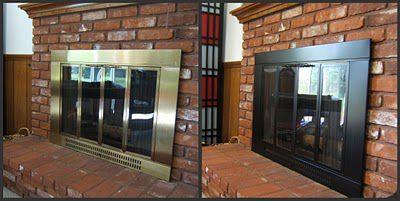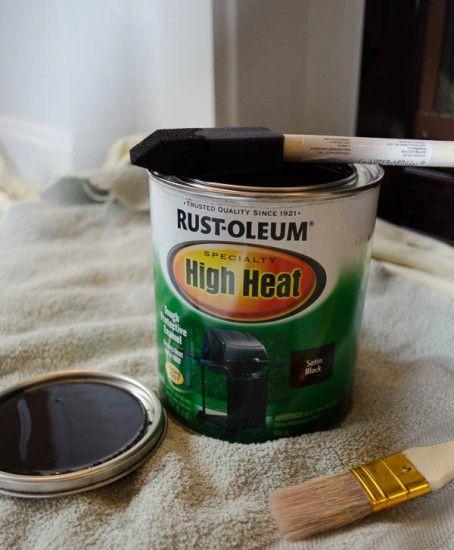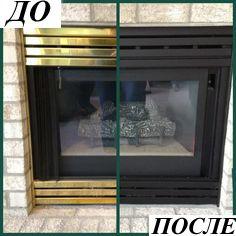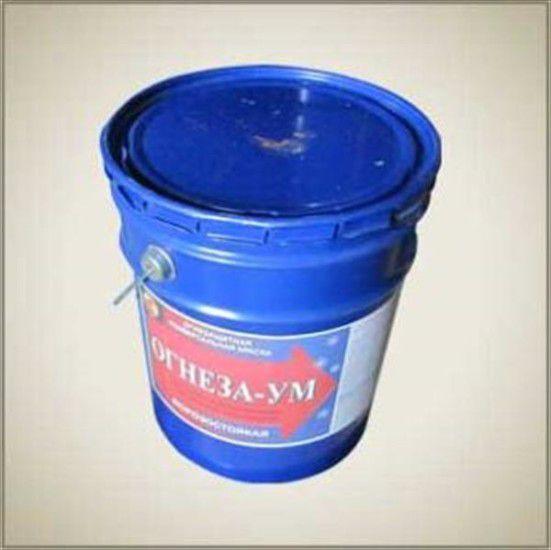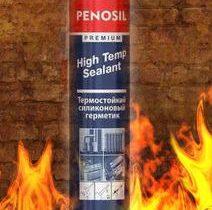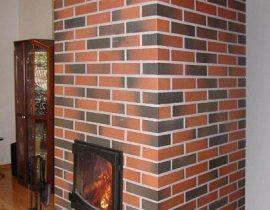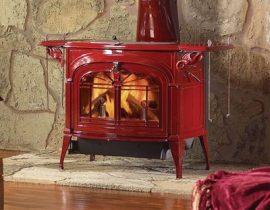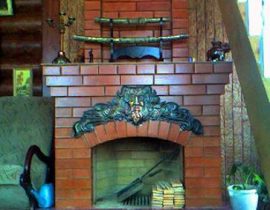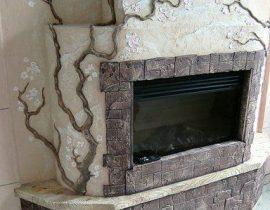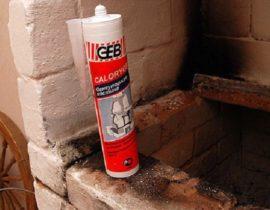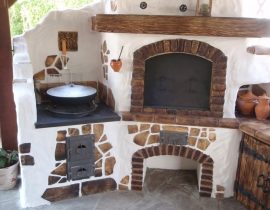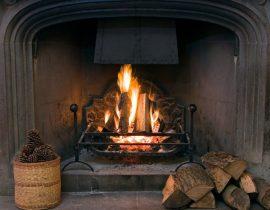Outdoor and home fireplaces have long ceased to be a defiantly luxurious item in a summer cottage or in a country house.
So, a fireplace in nature, combined with a barbecue area or even built into a summer kitchen, is not only a decorative subject of the backyard landscape, but also a completely utilitarian structure.
You can not only admire the open fire burning in the outdoor fireplace and warm yourself near it on cool evenings, but also use it to prepare a variety of delicious dishes for your guests. But it is important to know that the surfaces of such structures that are in direct contact with fire are subject to severe wear. To increase the service life of all parts of your stove or fireplace and give a pleasant aesthetic appearance, heat-resistant varnish will help you.
Content
Is there an urgent need to varnish the stove or fireplace?
Already when the surface temperature (brick or metal) reaches more than 80 degrees, dry dust particles begin to sublimate from it. In this case, a lot of harmful substances are formed. The chimney system, especially in an open fireplace, does not contribute to the complete removal of combustion products.To ensure that the internal heating surfaces of stoves and fireplaces do not interact with open fire, a special heat-resistant varnish is applied to them.
In addition, such a varnish protects the surfaces of fireplaces and stoves from premature wear.
Aesthetic impression
Indoor and outdoor fireplaces carry a powerful aesthetic charge. They symbolize the reliability of the home, its solidity. But as they are used, after interacting with fire, the surfaces of these structures acquire a pale, worn appearance. The brick surface wears out and scratches, the plaster is covered with cracks, parts made of metal are covered with rust, surfaces made of artificial stone can have a porous surface and serve as a kind of dust collector.
Almost all unpainted and untreated surfaces of fireplaces and stoves collect a large amount of dust on themselves, which looks very sloppy. Such elements require constant cleaning, but their surface, cracked by fire and high temperature, turns cleaning into continuous torment.
Everything changes if the surfaces of fireplaces and stoves are painted with fire-resistant paint or coated with heat-resistant varnish. Such coatings can be used on almost all types of fireplace and stove surfaces: those made of metal, stone, brick, and also covered with plaster.
How to properly varnish fireplaces and stoves
As a rule, in central Russia, fireplaces, unlike stoves, are not the main sources of heating. There are cases when, due to too much draft, fireplaces even cool the room, but this is on the conscience of the stove-makers who designed and laid these fireplaces.
On the other hand, the stove in the house, by definition, must “breathe” with heat. It turns out that for different heating devices, and even more so for their different components, varnish or paint should be used, designed for different operating temperatures.
Influence of the design of fireplaces on their finishes
Internal fireplaces by design can be divided into the following main types:
- Consisting of a metal body, closed with a glass lid and a metal chimney. In this case, it is necessary to pay attention to the processing of the metal, which has excellent thermal conductivity. In the furnace zone, the temperature effect will be maximum, in the chimney zone it will be somewhat cooler. Particular attention should be paid to the elements that fasten the doors to the firebox. Excessive exposure to close fire can damage them.
- Fireplaces consisting of an open metal firebox. In this case, the places of processing are the same as those described above.
- Consisting of a brick body, the firebox in which is closed with a glass door and a metal chimney. The maximum effect of the temperature of the fire in this case falls on the furnace and fasteners. But, unlike the metal of the fasteners, the bricks in the furnace have a different coefficient of thermal conductivity, which means that you will need to choose a different paint or varnish for their processing. A similar varnish or paint must be chosen for processing a brick firebox that does not have closing glass doors.
It is also necessary to pay attention to the processing of all metal parts of the fireplace. These may include a decorative grill, a firebox door, a metal firebox body and the first knee of a metal chimney.For metal processing, especially if you want to preserve its appearance, you must use a special heat-resistant varnish for metal parts.
Remember that the treatment of heating elements with varnish or paint that is not designed for exposure to high temperatures can lead to their ignition and to sad consequences.
Please note that dust accumulated on the surface of the fireplace does not have useful properties and must be cleaned regularly.
Influence of stove design on their finish
Stoves in the house are devices that require constant operation, and therefore constant care. Unlike fireplaces that work sporadically, the stove in the house, especially in winter, can be used almost around the clock. In this regard, the requirements for the materials from which furnaces are built, as well as for their processing, will be higher.
Consider the main types of furnaces and how to process them
- Massive furnaces with a large furnace area and an extensive inner surface - according to their characteristics, they are close to traditional Russian furnaces.
- Lightweight furnaces, usually made of metal, furnaces incorporating gas generating systems.
In any case, heat-resistant paints or lacquers must be used in the finishing of stoves, and the degree of resistance of such processing materials to fire should increase as the area to be treated approaches an open fire.
Please note that various external surfaces of the ovens may heat up unevenly - this is due to the design features.In this connection, it is possible to determine the need for more intensive processing after a test run, which must be carried out several times, alternating with cooling cycles.
To give brick ovens an attractive appearance, you can paint them with heat-resistant paint, while the seams between the bricks can be covered with a more contrasting varnish or paint. It is also possible to paint or varnish plasters and even various types of decorative tiles, which are often just a mixture of cement and sand.
Save materials
When processing a stove or fireplace, their various sections can be treated with paint or varnish with different temperature characteristics. In this case, it makes sense to keep a small stock of each of the types of processing and protective materials in order to carry out maintenance work on the stove or fireplace as needed. In this case, the use of "native" material will allow you to carry out repairs almost imperceptibly even for the most demanding look.
How to properly apply varnish or paint on a fireplace or stove?
After selecting the necessary materials for processing and protecting the stove or fireplace, you can begin to apply them. This procedure is quite within the power even for an unprepared person.
First of all, thoroughly clean the surface of dirt, dust and debris. Carefully remove all combustion products and their traces formed after the test fire. Clean the surface if necessary and correct any minor defects found.
When choosing a decorative or protective coating, try to choose paint or varnish:
- one manufacturer;
- inside - one type;
- cans of paint or varnish of the same series.
Do not forget that finishing the stove or fireplace with varnish or paint can change the interior of your home. Therefore, when choosing a paint or varnish, be sure to imagine how it will look in your interior.
Almost any heating devices with an open flame source can be treated with varnish or paint.
Video: Varnish outdoor fireplace
It is worth noting that if your stove or fireplace is outdoors, it must be covered with a protective heat-resistant varnish or paint. Thus, you protect yourself from the penetration of moisture into the product and its destruction as a result of temperature changes! This is especially true for our latitude of residence!
If you do not varnish your outdoor fireplace, the timing of its destruction varies. 2 to 5 years!

